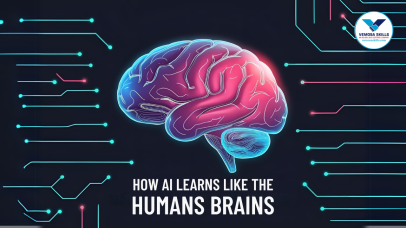Neural Networks Explained: How AI Learns Like the Human Brain
Have you ever thought about how your phone knows it's you when you look at your face when you unlock it? Or how Netflix always knows what show you'll watch next? It's not magic - it's called a neural network. And believe it or not, it's designed just like your brain.
Let’s break it down in simple English — no tech degree needed. Just a little curiosity can do the work.
The Brain Behind the Tech
Think about how you learned to identify a dog. Understand this pattern.
Let's start at the beginning. When you were a child, someone must have pointed to a furry creature and said, "Look, that's a dog." Over time, you may have seen more dogs like this - big, small, scary, and silly. Your brain starts to notice these patterns: four legs, wagging tails, barking sounds, etc.
This is how AI learns - with examples. With lots of examples.
And just like your brain uses neurons to process what it sees, hears, and feels, AI uses artificial “neurons” that we call neural networks.
So, basically, we have created machines that think like us - at least to some extent.
So What Is a Neural Network?
A neural network is a computer system designed to understand information just like our brains do. It looks at data, finds patterns, and makes decisions.
Still confused? Let's relate this to something familiar.
Imagine you’re trying to teach your friend to identify a pizza.
You show them 100 pictures - some of pizza and some of other things - you tell them what goes into a pizza, and your friends start noticing those things: Like cheese, crust, maybe pepperoni. After some time, they get better at saying, “Yes, it’s pizza” or “No, it’s a salad.”
This is exactly how a neural network works. It learns from examples, gets better with experience, and (if trained well) can be almost always right.
Breaking It Down: How Neural Networks Actually Work
Here’s a friendly breakdown of what’s going on behind the scenes:
1. Input Layer: Feeding the Brain
This is where the system receives information – such as pixels from an image or words in a sentence.
Imagine it as a huge network of tiny dots (neurons) that light up when data is fed into them.
Actual brain-similar part: The part of your brain that receives sensory input (like your eyes or ears).
2. Hidden Layers: The Thinking Process
These layers do the real work. They look for patterns and relationships in the data — like “round shape + melted cheese = maybe pizza?”
The more hidden layers you have, the deeper the learning — this is where the term “deep learning” comes from.
Think of it like this: your brain processes and compares everything you see.
3. Output Layer: The Decision
After calculating, the neural network gives you the answer: “This image is 92% likely to be a pizza.”
If it's wrong, it doesn't just shrug and walk away. It learns. That's where the magic happens.
Learning from mistakes (as we do)
When a neural network makes a mistake, it uses a method called backpropagation to correct it.
It's like your brain is saying, "Oh, that wasn't a dog; that was a fox." And the next time you see a fox, you're a little smarter.
This is how neural networks improve — not immediately, but slowly over time, through thousands (sometimes millions) of examples.
Real-Life Neural Networks You Use Every Day
You might not be able to see them, but neural networks are everywhere:
- Face unlock on your phone
- Google Translate when you're trying to read a French menu
- Instagram filters that turn your selfies into art
- Spotify recommendations that read your mood
- Self-driving cars that know when to stop, turn, or honk the horn
Every time these devices identify, guess what come next, or personalize something for you, they are using neural networks.
Neural Network vs. Human Brain: What’s the Difference?
Brain :
- Made of 86 billion real neurons
- Learns from senses and emotions
- Fast but sometimes emotional
- Can multitask with creativity
Neural Network :
- Made of artificial “neurons” (math-based)
- Learns from data
- Fast and logical (but lacks gut feeling)
- Great at specific tasks (like recognizing images)
We're still a long way from copying the full power of the human brain, but neural networks are the first step in that direction.
Why Should You Care?
Because neural networks are shaping your world.
They're behind medical breakthroughs like early cancer detection, financial tools that detect fraud, and even amazing pictures or art created by AI artists.
And knowing how they work helps you understand the technology that affects your life every day - from what you watch to what you buy.
Also, if you are ever curious about learning AI or machine learning, neural networks are the starting point for you.
Too Long; Didn't Read
- Neural networks are inspired by how the human brain works.
- They understand information in layers: input → hidden → output.
- They learn through repetition and correction—just like us.
- They're used in everything from social media to healthcare.
Understanding them helps you make sense of the smart tech all around you.
Final Thoughts
The next time your phone guesses your next word or your app suggests your favorite song before you even ask, know this: A tiny bit of brain-inspired AI is working quietly in the background, learning from you, for you.





